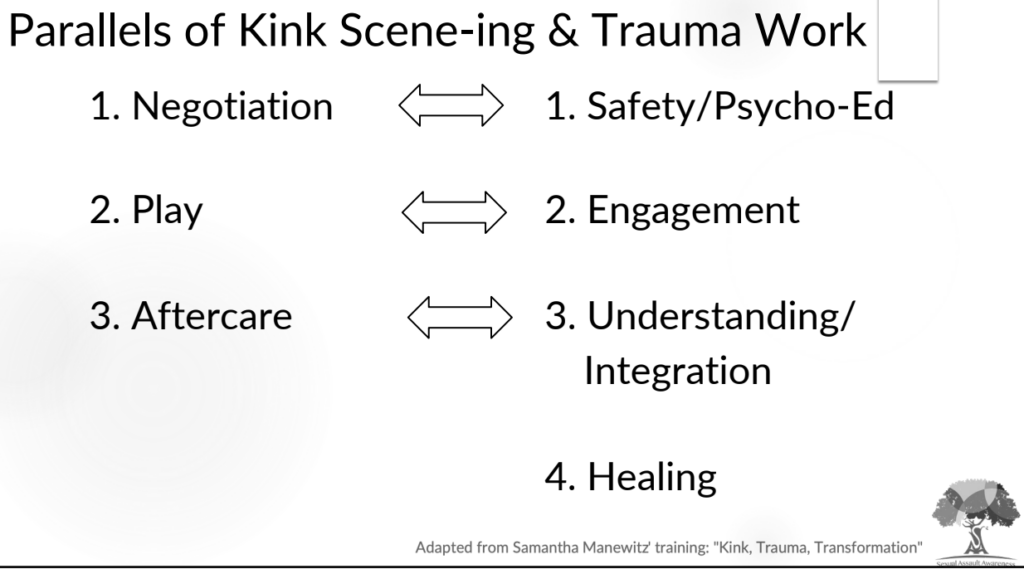Many people have reported how kink and BDSM have helped them work through traumatic situations in their past however, there wasn’t much research/data around how kink and BDSM could help someone work through past traumatic events in their life. I recently completed a course from TASHRA (The Alternative Sexual Health Research Alliance) entitled Kink & Healing: Two Approaches with Julie Lehman, LMFT and Andrew Pari, LCSW, CCTP. I love this organization as it really is doing some interesting things around alternative sexualities and therapy and any training they put on or put out is thorough and research-based. This training talked about how kink and BDSM scenes are being used for healing within participants. It is clear that kink is NOT therapy, but it IS therapeutic, and preliminary research is being conducted to explore ways that kink can have therapeutic benefit for those that are experiencing post-traumatic stress disorder, anxiety, depression, and other mental health concerns. Personally being in the kink would for the past 13 years I can say that kink and BDSM has immensely helped me with trauma, anxiety, and spiritual growth so I know first hand how beneficial it can be. This training offered significant insight to who is consciously using kink to address trauma, how much, the similarities between therapeutic interventions and models of therapy and kink scene/play, and a model of how clients can consciously use kink to work through their own trauma.
People Are Doing This! But Who, How Much, and for what Issues?
Dr. Richard Sprott presented some very preliminary answers to two questions around using kink scenes to address past traumas. At the time of presenting he shared that these numbers were just informational and expected to change with more respondents.
Have you have ever consciously used a kink scene to address past trauma?
33% Yes (83)
55% No (139)
13% Not sure (32)
How many scenes have you done that intentionally addressed past trauma?
4+ scenes: 28% (28)
1-3 scenes: 38% (37)
1 scene: 10% (10)
Not Sure: 23% (23)
The nature of the original traumatic experience was overwhelming sexual, such as sexual assault, abuse, childhood sexual abuse, and rape. Additional traumatic experiences were related to partner abuse, shame, and consent.
While it is always a fine line for therapists who work with kinksters advising them to use strong caution when working with mental health themes such as trauma in the context of kink, what we are understanding is that people are doing this and finding a lot of benefit from it. So it is good that efforts are being made to understand it.
Here is an interview with Licensed Clinical Social Worker and Certified Sex Therapist Samantha Manewitz did on “Can Kink Help Transform Trauma?” and the parallels between kink-scening and trauma work.

A Proposed Model for Constructing these Scenes
The biggest take away I took from the training was a proposed model, called the Somatic Mastery of Sexual Trauma Model, that Andrew Pari, LCSW, CCTP presented on. I italicized proposed because this isn’t a currently accepted or validated model for trauma, but I found it a nice framework on how conscious kink and therapy could intersect to address traumatic experiences. The model looks like this:

I love the collaborative nature of this model where the therapist can do much of the work with the client and help them create spaces to prepare for re-enactment, role play, aftercare, etc. as well as offer so much clinical treatment around the trauma. The Somatic Mastery of Sexual Trauma Model is a therapeutic blend of Prolonged Exposure Therapy, Attachment Theory, Dramatherapy, and Trauma Release Exercise.
If you are interested in working with a sex therapist to work through trauma with kink and BDSM, please reach out below!
